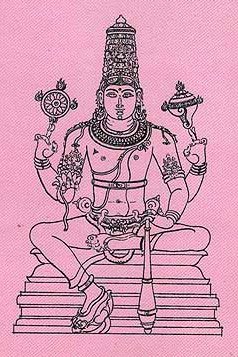Dviguna, Dviguṇa, Dvi-guna: 13 definitions
Introduction:
Dviguna means something in Hinduism, Sanskrit, Buddhism, Pali, Marathi. If you want to know the exact meaning, history, etymology or English translation of this term then check out the descriptions on this page. Add your comment or reference to a book if you want to contribute to this summary article.
In Hinduism
Pancaratra (worship of Nārāyaṇa)
Source: University of Vienna: Sudarśana's Worship at the Royal Court According to the AhirbudhnyasaṃhitāDviguṇa (द्विगुण) refers to a “double (Brāhmaṇa)” (i.e., ‘one worth twice as much as a Brāhmaṇa’), according to the Ahirbudhnyasaṃhitā, belonging to the Pāñcarātra tradition which deals with theology, rituals, iconography, narrative mythology and others.—Accordingly, “[...] Out of [his own] head indeed has God, the Lord, created the King in ancient times. Therefore does he have his head anointed and stands above all beings. The King is praised in Revealed Knowledge and Systematized Bodies of Knowledge as a double Brāhmaṇa (dviguṇa—dviguṇo brāhmaṇo) (i.e. as worth twice as much as a Brāhmaṇa). If one is hostile to him out of delusion, that fool is hostile to Hari [himself]”.

Pancaratra (पाञ्चरात्र, pāñcarātra) represents a tradition of Hinduism where Narayana is revered and worshipped. Closeley related to Vaishnavism, the Pancaratra literature includes various Agamas and tantras incorporating many Vaishnava philosophies.
Shaivism (Shaiva philosophy)
Source: SOAS University of London: Protective Rites in the Netra TantraDviguṇa (द्विगुण) refers to the “twofold (lotus)”, according to the Netratantra of Kṣemarāja: a Śaiva text from the 9th century in which Śiva (Bhairava) teaches Pārvatī topics such as metaphysics, cosmology, and soteriology.—Accordingly, [verse 6.28-32ab, while describing the arkamaṇḍala]—“[...] The twofold lotus (dviguṇa—tu dviguṇaṃ padmaṃ) outside follows the sequence [of consonants that] begins with ka and ends with sa. [This is] enclosed with the syllables saḥ, etc.. And in that, is the name of the person to be healed Outside [of this, the Mantrin draws] the disc of the sun, and below he should completely surround it on all sides beginning in the east”.

Shaiva (शैव, śaiva) or Shaivism (śaivism) represents a tradition of Hinduism worshiping Shiva as the supreme being. Closely related to Shaktism, Shaiva literature includes a range of scriptures, including Tantras, while the root of this tradition may be traced back to the ancient Vedas.
Languages of India and abroad
Pali-English dictionary
Source: BuddhaSasana: Concise Pali-English Dictionarydviguṇa : (adj.) twofold; double.

Pali is the language of the Tipiṭaka, which is the sacred canon of Theravāda Buddhism and contains much of the Buddha’s speech. Closeley related to Sanskrit, both languages are used interchangeably between religions.
Marathi-English dictionary
Source: DDSA: The Molesworth Marathi and English Dictionarydviguṇa (द्विगुण).—a (S) Double, twice the quantity or the number.
Marathi is an Indo-European language having over 70 million native speakers people in (predominantly) Maharashtra India. Marathi, like many other Indo-Aryan languages, evolved from early forms of Prakrit, which itself is a subset of Sanskrit, one of the most ancient languages of the world.
Sanskrit dictionary
Source: DDSA: The practical Sanskrit-English dictionaryDviguṇa (द्विगुण).—a. double, twofold; पितुर्वधव्यसनमिदं हि येन मे चिरादपि द्विगुणमिवाद्य वर्धते (piturvadhavyasanamidaṃ hi yena me cirādapi dviguṇamivādya vardhate) Mu.5.6 (driguṇākṛ to plough twice; dviguṇīkṛ to double, increase; dviguṇībhūta a. double, augmented).
Dviguṇa is a Sanskrit compound consisting of the terms dvi and guṇa (गुण).
Source: Cologne Digital Sanskrit Dictionaries: Shabda-Sagara Sanskrit-English DictionaryDviguṇa (द्विगुण).—mfn.
(-ṇaḥ-ṇā-ṇaṃ) 1. Twice, two times. 2. Multiplied by two, doubled. E. dvi two, and guṇa number.
Source: Cologne Digital Sanskrit Dictionaries: Cappeller Sanskrit-English DictionaryDviguṇa (द्विगुण).—[adjective] double, twofold, twice as much as ([ablative] or —°); dviguṇa & dviguṇatara (°—) [adverb], also [neuter] taram. Abstr. tā† [feminine], tva† [neuter]
--- OR ---
Dviguṇa (द्विगुण).—[adjective] double, twofold, twice as much as ([ablative] or —°); dviguṇa & dviguṇatara (°—) [adverb], also [neuter] taram. Abstr. tā† [feminine], tva† [neuter]
Source: Cologne Digital Sanskrit Dictionaries: Monier-Williams Sanskrit-English Dictionary1) Dviguṇa (द्विगुण):—[=dvi-guṇa] [from dvi] (or dvi-g) mfn. double, twofold, of 2 kinds, [Śatapatha-brāhmaṇa; ???] etc.
2) [v.s. ...] doubled id est. folded (garment), [Śatapatha-brāhmaṇa]
3) [v.s. ...] twice as large or as much as ([ablative]), [Yājñavalkya ii, 4]
4) [v.s. ...] ([compound]), [Manu-smṛti viii. 59]
5) Dviguṇā (द्विगुणा):—[=dvi-guṇā] [from dvi-guṇa > dvi] ind., with √kṛ, to plough twice, [Pāṇini 5-4, 59], [Kāśikā-vṛtti]
Source: Cologne Digital Sanskrit Dictionaries: Yates Sanskrit-English DictionaryDviguṇa (द्विगुण):—[(ṇaḥ-ṇā-ṇaṃ) a.] Twice.
Source: DDSA: Paia-sadda-mahannavo; a comprehensive Prakrit Hindi dictionary (S)Dviguṇa (द्विगुण) in the Sanskrit language is related to the Prakrit words: Diuṇa, Duuṇa, Duguṇa, Biuṇa.
[Sanskrit to German]
Sanskrit, also spelled संस्कृतम् (saṃskṛtam), is an ancient language of India commonly seen as the grandmother of the Indo-European language family (even English!). Closely allied with Prakrit and Pali, Sanskrit is more exhaustive in both grammar and terms and has the most extensive collection of literature in the world, greatly surpassing its sister-languages Greek and Latin.
Kannada-English dictionary
Source: Alar: Kannada-English corpusDviguṇa (ದ್ವಿಗುಣ):—[noun] the quantity, number, etc. that is twice the given quantity, number.
Kannada is a Dravidian language (as opposed to the Indo-European language family) mainly spoken in the southwestern region of India.
See also (Relevant definitions)
Starts with: Dvigunagollu, Dvigunaguggulu, Dvigunakar, Dvigunakarna, Dvigunakrita, Dvigunamgey, Dvigunata, Dvigunatara, Dvigunataram, Dvigunatva, Dvigunay, Dvigunaya.
Ends with: Pashcatpadadviguna, Taddviguna.
Full-text (+17): Biuna, Dvigunakarna, Duguna, Dvigunatva, Dvigunakrita, Dvigunita, Dvaigunya, Dvigunata, Dvigunatara, Dvigunataram, Dvaigunika, Dvigunaya, Dvigunibhu, Dvigunikri, Adhamarnika, Dvi, Dvigunibhuta, Duuna, Dvigunikrita, Diuna.
Relevant text
Search found 21 books and stories containing Dviguna, Dviguṇa, Dvi-guna, Dvi-guṇa, Dviguṇā, Dvi-guṇā; (plurals include: Dvigunas, Dviguṇas, gunas, guṇas, Dviguṇās, guṇās). You can also click to the full overview containing English textual excerpts. Below are direct links for the most relevant articles:
Manusmriti with the Commentary of Medhatithi (by Ganganatha Jha)
Verse 8.369 < [Section XLVI - Adultery]
Verse 8.191 < [Section XXXII - Deposits (nikṣepa)]
Verse 8.269 < [Section XLI - Verbal Assault (Abuse and Defamation)]
Garga Samhita (English) (by Danavir Goswami)
Verse 6.10.42 < [Chapter 10 - In the Description of the Gomatī River, the Glories of Cakra-tīrtha]
Chaitanya Bhagavata (by Bhumipati Dāsa)
Verse 1.7.5 < [Chapter 7 - Śrī Viśvarūpa Takes Sannyāsa]
Verse 1.12.212 < [Chapter 12 - The Lord’s Wandering Throughout Navadvīpa]
Bhakti-rasamrta-sindhu (by Śrīla Rūpa Gosvāmī)
Verse 3.2.83 < [Part 2 - Affection and Service (dāsya-rasa)]
The Linga Purana (by J. L. Shastri)
Chapter 75 - Monism of Śiva (śivādvaita) < [Section 1 - Uttarabhāga]
Vastu-shastra (3): House Architecture (by D. N. Shukla)
Related products
(+2 more products available)





